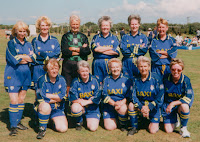But people in Preston always spoke very highly of the Dick, Kerr Ladies and I would often wonder about them with envy.
It wasn’t until 1972 that I began playing in a ladies’ team myself. The North West Women’s League was formed in the late 1960s and the FA finally lifted their ban on the ladies’ game in 1971.
Meeting them made me realise that their story was bigger than anyone could imagine and I knew that something needed to be done quickly otherwise their amazing story could have been lost forever.
I spent the next two years researching their history and my book was first published in 1994.
I feel very proud of bringing these ladies back together because it really did change all of our lives. Had I not captured the wealth of information about them when I did, a huge slice of women’s sporting and social history would have been lost without trace.
A bit of history
The Dick, Kerr Ladies began playing football at a munitions factory in Preston during the First World War to raise funds for wounded soldiers. Dick, Kerr and Company Limited enlisted the help of thousands of women while the men were away fighting in France.
The Dick, Kerr Ladies played their first game at Deepdale, the home of Preston North End on Christmas Day 1917 in front of 10,000 spectators. They won 4-0 and raised £600 for the wounded soldiers. And so began the most incredible success story in the history of women’s sport.
They went from strength to strength and always played in front of big crowds. On Boxing Day 1920 they played at Goodison Park, Everton in front of 53,000 spectators and there was around 10,000-14,000 who were unable to get inside the ground!
By 1921 they were the team that everyone wanted to see and had been booked to play an average of two games a week. In that year they played over 65 games of football while still working full-time at the factory and almost 900,000 people came to watch them.
However, the FA was not happy with the ladies’ success and on 5 December 1921 the FA banned them from using League grounds and effectively changed the course of the women’s game forever. The ban lasted for fifty years and was probably the biggest sporting injustice of the last century.
Imagine what could have happened if the women’s game had been allowed to grow at the same rate as men’s football and the top female players had an equal status on and off the field.
A call to write
It seems to me that football has been treated differently than most other sports. For example, other sporting superstars such as Jessica Ennis and Mo Farah are recognised equally for their individual success, but equal recognition doesn’t happen in football. Why do you think this is? Is it the nature of the sport itself? Or the historical context that surrounds it?
What female players do you think would compare to the top male players today?
Do you think it unfair that female players such as Kelly Smith and Stephanie Houghton do not get the same recognition as say Wayne Rooney or Gareth Bale?
It’s important to think about what events or people inspire or challenge you when you’re choosing something to write about. Then you’ll be more inspired to research and write!
My own experiences as a player gave me the inspiration to write about the Dick, Kerr Ladies. Is there an event in your life, or an event in history or perhaps a role model that has inspired you? Think about it, then go write!





